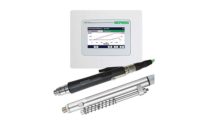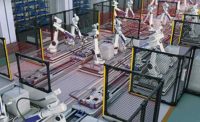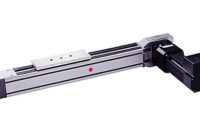On May 11, the Occupational Safety and Health Administration (OSHA) leveed $822,000 in fines on Lloyd Industries Inc., a manufacturer of ventilation, duct, and fire safety products for stadiums and other high-profile public buildings.
According to OSHA, workers at the Montgomeryville, PA, company were routinely exposed to crushing and amputation hazards from unguarded machinery. Since 2000, approximately 40 serious injuries have occurred among the company’s employees, including serious cuts as well as crushed, fractured, dislocated, and amputated fingers. Including the latest penalty, OSHA has fined the company more than $1 million since 2000.
The most recent inspection was prompted by a July 2014 incident that resulted in the amputation of three fingers on a worker’s right hand. In that incident, the die on a press brake dropped on a worker’s right hand. According to OSHA, the machine lacked required safety guards and had not worked properly before the incident.
Machine guarding violations are among OSHA’s most frequently cited standards, responsible for more than 2,500 citations and more than $8.6 million in penalties in fiscal year 2014. According to OSHA, more than 200,000 American workers every year suffer cuts and amputations from contact with operating parts of dangerous machinery.
It doesn’t have to be that way. Implementing and maintaining proper safeguards can help manufacturers protect workers from preventable injuries. What’s more, manufacturers have many options for machine guarding, and new technologies have greatly simplified the process of implementing them.
Light Curtains
Light curtains are ideal when workers need to access the guarded area frequently, and physical guards would be an impediment.
An elongated photoelectric sensor, a light curtain consists of two parts: a transmitter and a receiver. The transmitter contains a series of LEDs that project an array of synchronized, parallel infrared light beams to the receiver. If an opaque object blocks any of the beams, the light curtain sends a stop signal to the guarded machine.
Light curtains come in lengths of 4 to 96 inches. They can guard small areas, such as the access point of an assembly press, or they can enclose large areas, such as a robotic welding cell. The curtain’s range—the maximum distance between the transmitter and receiver—can vary from 1 to 240 feet.
For example, the new deTec2 Core light curtain from SICK Inc. has a resolution of 14 or 30 millimeters and a protective field height of 300 to 2,100 millimeters. Designed for Performance Level C and Safety Integrity Level 1 applications, it is available with enclosure ratings IP 65 and IP 67.
“As well as its new innovative bracket system and being able to operate down to -30 C, the deTec2 Core has no blind zones,” says Martin Kidman, safety specialist with SICK. “It is extremely easy and quick to set up and commission, without a PC, so the operator gets rapid protection against unsafe access whilst enabling ongoing efficient operation. For machine builders and systems integrators, the deTec2 Core is simple to include in the safety system design.”
Since the receiver’s sensor works only in protective mode, configuration and range adjustment is automatic. No additional setup is required. Diagnostic codes are simple, and additional functions can be set up via safety relays or through the safety controller.
An innovative mounting bracket configuration, semicircular contours and alignment LEDs greatly facilitate the alignment process, so the curtain can be installed quickly and easily. Safety distances can be minimized to achieve best-possible machine integration and higher operator productivity.
Safety Laser Scanners
Safety laser scanners are a cost-effective and flexible device for guarding large danger zones. A safety laser scanner is an optoelectronic device that uses diffused reflection of emitted light to detect the intrusion of person or object in a specified area. They can be used in stationary or mobile applications.
The Rotoscan RS4 safety laser scanner from Leuze Electronic Inc. has been equipped with requirement-compliant function packages. Nearly 20 different models are available with various protective field ranges and switching outputs. By varying field combinations and resolutions, the number of model possibilities reaches into the four-digit range. As a result, a custom scanner can be created for nearly every application.
Scanners with a protective field range of up to 6.25 meters are available. Engineers can choose from three function packages: basic, extended and Motion Monitoring. The basic function package is intended for engineers who want to implement danger-zone guarding. The extended variant facilitates the construction of vertical point-of-operation guarding and access guarding. The Motion Monitoring function package was developed specifically for safeguarding the transportation path of mobile systems, such as automated guided vehicles.
Within each function package, protective field ranges are available in three levels: 2.15, 4 and 6.25 meters. For the large operating ranges, models are available with integrated interfaces for the AS-i and Profibus DP safety bus systems.
Keeping in Control
Light curtains, laser scanners and other technologies are only as good as the controller that receives and acts upon their output signals.
The NX Series of safety controllers from OMRON Automation and Safety combines automation and safety on the same EtherCAT network in a mixed I/O backplane to promote design flexibility and minimize wiring costs. A single intuitive software programming environment reduces machine and safety design time, while an auto configuration restart function eliminates the need for tools or software to exchange I/O hardware.
“The NX safety controller…represents a decisive step towards the complete integration of safety, logic, motion and vision disciplines—and it does so in one software platform, on one network, and in one control system,” says Matt Dodds, safety product marketing manager at OMRON.
The functionality and flexibility of these controllers make them ideal for applications such as automotive robotic workcells; large, flexible packaging machines; and material handling workcells with multiple access points.
The open protocol Safety over EtherCAT defines a safety-related communication layer for EtherCAT. The NX safety controller and the distributed safety I/O can be freely placed in the EtherCAT network, and their integration in OMRON’s Sysmac Studio software environment simplifies initial system design, setup, and maintenance of the application.
“NX series safety controllers add ease and flexibility in programming the safety system with direct access, by the PLC, to all status and information about each safety input and output by simply assigning a variable,” explains Dodds. “As a result, faster design and commissioning can be realized.”
Banner Engineering Corp. has recently introduced the XS26-2 expandable safety controller. With the capability to add up to eight expansion I/O modules, the controller can easily be adapted to diverse automation requirements and address a wide range of safeguarding applications.
The base controller models have 26 input terminals, four terminals for two redundant safety PNP outputs, and a USB connection for loading configurations. Base models are available with an optional on-board display or an embedded Ethernet IP/Modbus TCP capability for access to live I/O status and system diagnostics to assist in troubleshooting and commissioning.
“Control engineers and maintenance staff are required to do more with fewer resources and, as a result, they value reliable, easy-to-use safety products,” says Tom McMonagle, senior director of product planning at Banner. “In response, the engineering teams at Banner have…focused on developing an industrially hardened safety control system and a highly intuitive, easy-to-learn graphical user interface.”
The safety controller’s complementary PC graphical user interface configuration software is simple, uncluttered and easy to navigate for configuring and documenting safety functions and assessing the status of connected input or output devices. The system configuration tool uses a function block diagram format that consists of pre-engineered and pretested safety function blocks, as well as a set of Boolean functions. As the function block configuration is created, a corresponding logic ladder reference diagram and a text-based summary are created.
To meet requirements of diverse applications, the safety controller offers six I/O expansion module models with a variety of safety inputs, solid-state safety outputs and safety relay outputs. For efficient terminal use, the base controller and expansion modules allow a portion of the safety inputs to be configured as outputs.
During the configuration process, up to 64 virtual status registers are automatically populated with names of the input and output devices connected to the safety controller system. This enables remote access to the I/O device and system status information.
There’s an App for That
Engineers can now use smart phones or tablets to conduct risk assessments of potentially hazardous machinery with a free app from Pilz Automation Safety.
With the PASmsi app, engineers can do calculations in several categories, including risk estimation and determining achievable performance levels. Data can be saved or exported to projects for later use.
No knowledge of mathematical correlations is required. For example, to determine the necessary risk level of a machine, the engineer simply answers a series of predefined questions. The app will make all the calculations in the background and provide the result immediately.
In addition, the app supports evaluations, project management and photo documentation.
Regular updates ensure that engineers will always have access to the latest safety information.
The app can be downloaded free of charge for the Android (Google) and iOS (Apple) operating systems. For more information visit: www.pilz.com/de-DE/knowhow/books/app-pasmsi.








